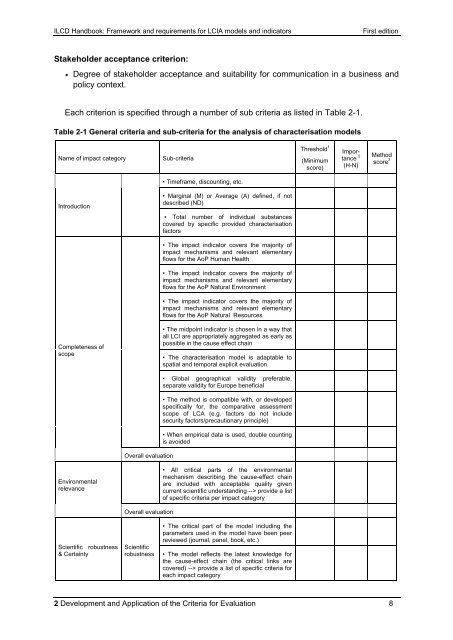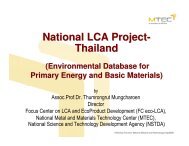ILCD Handbook: Framework and requirements for LCIA models and ...
ILCD Handbook: Framework and requirements for LCIA models and ...
ILCD Handbook: Framework and requirements for LCIA models and ...
Create successful ePaper yourself
Turn your PDF publications into a flip-book with our unique Google optimized e-Paper software.
<strong>ILCD</strong> <strong>H<strong>and</strong>book</strong>: <strong>Framework</strong> <strong>and</strong> <strong>requirements</strong> <strong>for</strong> <strong>LCIA</strong> <strong>models</strong> <strong>and</strong> indicators First edition<br />
Stakeholder acceptance criterion:<br />
Degree of stakeholder acceptance <strong>and</strong> suitability <strong>for</strong> communication in a business <strong>and</strong><br />
policy context.<br />
Each criterion is specified through a number of sub criteria as listed in Table 2-1.<br />
Table 2-1 General criteria <strong>and</strong> sub-criteria <strong>for</strong> the analysis of characterisation <strong>models</strong><br />
Name of impact category Sub-criteria<br />
Introduction<br />
Completeness of<br />
scope<br />
Environmental<br />
relevance<br />
Scientific robustness<br />
& Certainty<br />
Overall evaluation<br />
Overall evaluation<br />
Scientific<br />
robustness<br />
• Timeframe, discounting, etc.<br />
• Marginal (M) or Average (A) defined, if not<br />
described (ND)<br />
• Total number of individual substances<br />
covered by specific provided characterisation<br />
factors<br />
• The impact indicator covers the majority of<br />
impact mechanisms <strong>and</strong> relevant elementary<br />
flows <strong>for</strong> the AoP Human Health<br />
• The impact indicator covers the majority of<br />
impact mechanisms <strong>and</strong> relevant elementary<br />
flows <strong>for</strong> the AoP Natural Environment<br />
• The impact indicator covers the majority of<br />
impact mechanisms <strong>and</strong> relevant elementary<br />
flows <strong>for</strong> the AoP Natural Resources<br />
• The midpoint indicator is chosen in a way that<br />
all LCI are appropriately aggregated as early as<br />
possible in the cause effect chain<br />
• The characterisation model is adaptable to<br />
spatial <strong>and</strong> temporal explicit evaluation<br />
• Global geographical validity preferable,<br />
separate validity <strong>for</strong> Europe beneficial<br />
• The method is compatible with, or developed<br />
specifically <strong>for</strong>, the comparative assessment<br />
scope of LCA (e.g. factors do not include<br />
security factors/precautionary principle)<br />
• When empirical data is used, double counting<br />
is avoided<br />
• All critical parts of the environmental<br />
mechanism describing the cause-effect chain<br />
are included with acceptable quality given<br />
current scientific underst<strong>and</strong>ing --> provide a list<br />
of specific criteria per impact category<br />
• The critical part of the model including the<br />
parameters used in the model have been peer<br />
reviewed (journal, panel, book, etc.)<br />
• The model reflects the latest knowledge <strong>for</strong><br />
the cause-effect chain (the critical links are<br />
covered) --> provide a list of specific criteria <strong>for</strong><br />
each impact category<br />
Threshold 1<br />
(Minimum<br />
score)<br />
Importance<br />
2<br />
(H-N)<br />
Method<br />
score 3<br />
2 Development <strong>and</strong> Application of the Criteria <strong>for</strong> Evaluation 8



